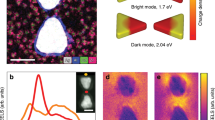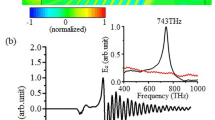Abstract
We investigate the influence of a dark photon on the Casimir effect and calculate the corresponding leading contribution to the Casimir energy. For expected magnitudes of the photon - dark photon mixing parameter, the influence turns out to be negligible. The plasmon dispersion relation is also not noticeably modified by the presence of a dark photon.
Similar content being viewed by others
Notes
Remember that the es charge is expressed in Heaviside-Lorentz units. If es is expressed in Gaussian units common in plasma physics, we must replace es with \(\sqrt {4\pi }e_{s}\) in the formulas.
In plasma, photons acquire an effective mass [44], and therefore Aμ in a metal can have a nonzero longitudinal component.
It has been experimentally demonstrated that the Casimir force between metallic films decreases significantly when the layer thickness is less than the skin depth, which for most common metals is about 10− 8 m [57]
References
Fabbrichesi, M., Gabrielli, E., Lanfranchi, G.: The Physics of the Dark Photon: A Primer. Springer Nature: Cham, Berlin (2021). https://doi.org/10.1007/978-3-030-62519-1
Goodsell, M., Jaeckel, J., Redondo, J., Ringwald, A.: Naturally Light Hidden Photons in LARGE Volume String Compactifications. JHEP 11, 027 (2009). https://doi.org/10.1088/1126-6708/2009/11/027
Holdom, B.: Two U(1)’s and Epsilon Charge Shifts. Phys. Lett. B 166, 196–198 (1986). https://doi.org/10.1016/0370-2693(86)91377-8
Filippi, A., De Napoli, M.: Searching in the dark: the hunt for the dark photon. Rev. Phys. 5, 100042 (2020). https://doi.org/10.1016/j.revip.2020.100042
Dienes, K. R., Kolda, C. F., March-Russell, J.: Kinetic mixing and the supersymmetric gauge hierarchy. Nucl. Phys. B 492, 104–118 (1997). https://doi.org/10.1016/S0550-3213(97)00173-9
Ruegg, H., Ruiz-Altaba, M.: The Stueckelberg field. Int. J. Mod. Phys. A 19, 3265–3348 (2004). https://doi.org/10.1142/S0217751X04019755
Okun, L. B.: Limits of electrodynamics: paraphotons? Sov. Phys. JETP 56, 502–505 (1982). http://www.jetp.ac.ru/cgi-bin/e/index/e/56/3/p502?a=list
Jaeckel, J.: A force beyond the Standard Model - Status of the quest for hidden photons. Frascati Phys. Ser. 56, 172–192 (2012). https://arxiv.org/abs/1303.1821
Flambaum, V. V., Samsonov, I. B., Tran Tan, H. B.: Interference-assisted detection of dark photon using atomic transitions. Rev. Phys. D 99, 115019 (2019). https://doi.org/10.1103/PhysRevD.99.115019
Blasone, M., Vitiello, G.: Quantum field theory of fermion mixing. Annals Phys 244, 283–311 (1995). [erratum: Annals Phys. 249 (1996), 363–364]. https://doi.org/10.1006/aphy.1995.1115
Blasone, M., Capolupo, A., Romei, O., Vitiello, G.: Quantum field theory of boson mixing. Phys. Rev. D 63, 125015 (2001). https://doi.org/10.1103/PhysRevD.63.125015
Ji, C. R., Mishchenko, Y.: The General theory of quantum field mixing. Phys. Rev. D 65, 096–015 (2002). https://doi.org/10.1103/PhysRevD.65.096015
Lamoreaux, S. K.: Casimir forces: Still surprising after 60 years. Physics Today 60N2, 40–45 (2007). https://doi.org/10.1063/1.2711635
Casimir, H. B. G.: On the Attraction Between Two Perfectly Conducting Plates. Indag. Math 10, 261–263 (1948). https://www.dwc.knaw.nl/DL/publications/PU00018547.pdf
Jaffe, R. L.: The Casimir effect and the quantum vacuum. Phys. Rev. D 72, 021301 (2005). https://doi.org/10.1103/PhysRevD.72.021301
Buhmann, S. Y.: Dispersion Forces I: Macroscopic Quantum Electrodynamics and Ground-State Casimir, Casimir-Polder and van der Waals Forces. Springer, Berlin (2012). https://doi.org/10.1007/978-3-642-32484-0
Buhmann, S. Y., Welsch, D. G.: Dispersion forces in macroscopic quantum electrodynamics. Prog. Quant. Electron 31, 51–130 (2007). https://doi.org/10.1016/j.pquantelec.2007.03.001
Jiang, Q.-D., Wilczek, F.: Quantum Atmospherics for Materials Diagnosis. Phys. Rev. B 99, 201104 (2019). https://doi.org/10.1103/PhysRevB.99.201104
Jiang, Q.-D., Wilczek, F.: Axial Casimir Force. Phys. Rev. B 99, 165402 (2019). https://doi.org/10.1103/PhysRevB.99.165402
Pálová, L., Chandra, P., Coleman, P.: The Casimir effect from a condensed matter perspective. Am. J. Phys. 77, 1055–1060 ((2009)). https://doi.org/10.1119/1.3194050
Belinfante, F. J.: The Casimir effect revisited. Am. J. Phys 55, 134–138 (1987). https://doi.org/10.1119/1.15230
Huang, K: Quantum Field Theory: From Operators to Path Integrals. Wiley-Interscience, New York (1998). https://doi.org/10.1002/9783527617371
Harris, E.G.: A Pedestrian Approach to Quantum Field Theory. Wiley-Interscience, New York (1972)
Itzykson, C., Zuber, J.-B.: Quantum field theory. Mcgraw-hill, New York (1980)
Flanders, H.: Differentiation Under the Integral Sign. Am. Math. Monthly 80, 615–627 (1973). https://doi.org/10.2307/2319163
Plunien, G., Müller, B., Greiner, W.: The Casimir Effect. Phys. Rept 134, 87–193 (1986). https://doi.org/10.1016/0370-1573(86)90020-7
Ingold, G.-L.: Casimir effect from a scattering approach. Am. J. Phys 83, 156–162 (2015). https://doi.org/10.1119/1.4896197
Milton, K. A.: The Casimir Effect: Physical Manifestations of Zero-Point Energy. World Scientific, Singapore (2001)
Mostepanenko, V. M., Trunov, N. N.: The Casimir Effect and its Applications. Clarendon Press, Oxford (1997)
Lambrecht, A., Reynaud, S.: Casimir force between metallic mirrors. Eur. Phys. J. D 8, 309–318 (2000). https://doi.org/10.1007/s100530050041
Glaister, P.: A “Flat” Function with Some Interesting Properties and an Application. Math. Gazette 75, 438–440 (1991). https://doi.org/10.2307/3618627
Economou, E. N: The Physics of Solids: Essentials and Beyond. Springer, Berlin (2010). https://doi.org/10.1007/978-3-642-02069-8_4
Ehrenreich, H., Cohen, M. H.: Self-Consistent Field Approach to the Many-Electron Problem. Phys. Rev. 115, 786–790 (1959). https://doi.org/10.1103/PhysRev.115.786
Cheng, C. C., Harris, E. G.: Waves and Instabilities in a Finite Plasma. Phys. Fluids 12, 1262–1270 (1969). https://doi.org/10.1063/1.1692662
Greiner, W.: Quantum Mechanics: Special Chapters. Springer, Berlin (1998). https://doi.org/10.1007/978-3-642-58847-1
Landau, L. D.: On the vibrations of the electronic plasma. J. Phys. (USSR) 10, 25–34 (1946)
Sagan, D.: On the physics of Landau damping. Am. J. Phys 62, 450–462 (1994). https://doi.org/10.1119/1.17547
Vlasov, A. A.: Theory of Vibrational Properties of Electron Gas and Its Applications. Uch. Zapiski MGU, Fizika 75. book II, part 1 [in Russian] (1945)
Rukhadze, A. A., Semenov, V. E.: On a simplified description of waves in non-collision plasmas, Izvestiya VUZ. Applied Nonlinear Dynamics, 28N5 460–464. [in Russian]. https://doi.org/10.18500/0869-6632-2020-28-5-459-464 (2020)
Popov, V. Yu., Silin, V. P.: Vlasov Modes in the Theory of Ion-Acoustic Turbulence. Plasma Phys. Rep 40, 298–305 (2014). https://doi.org/10.1134/S1063780X14040060
Graham, P. W., Mardon, J., Rajendran, S., Zhao, Y.: Parametrically enhanced hidden photon search. Phys. Rev. D 90, 075017 (2014). https://doi.org/10.1103/PhysRevD.90.075017
Panofsky, W. K. H., Phillips, M: Classical Electricity and Magnetism. Addison-Wesley, New York (1962)
Garg, A.: Conductors in quasistatic electric fields. Am. J. Phys 76, 615–620 (2008). https://doi.org/10.1119/1.2894525
Robles, P., Claro, F.: Can there be massive photons? A pedagogical glance at the origin of mass. Eur. J. Phys 33, 1217–1225 (2012). https://doi.org/10.1088/0143-0807/33/5/1217
Barton, G., Dombey, N.: The Casimir Effect With Finite Mass Photons. Annals Phys 162, 231–272 (1985). https://doi.org/10.1016/0003-4916(85)90162-9
Bezerra, V. B., Klimchitskaya, G. L., Mostepanenko, V. M.: Higher-order conductivity corrections to the Casimir force. Phys. Rev. A 62, 014102 (2000). https://doi.org/10.1103/PhysRevA.62.014102
Bordag, M., Klimchitskaya, G. L., Mohideen, U., Mostepanenko, V. M.: Advances in the Casimir Effect. Oxford University Press, Oxford (2009)
Gradshteyn, I. S., Ryzhik, I. M.: Table of Integrals, Series, and Products, 7th edn. cademic Press, Amsterdam (2007)
Bezerra, V. B., Klimchitskaya, G. L., Romero, C.: Perturbation expansion of the conductivity correction to the casimir force. Int. J. Mod.Phys. A 16, 3103–3115 (2001). https://doi.org/10.1142/S0217751X01004426
Tsang, T.: Classical Electrodynamics. World Scientific, Singapore (1997)
Chiles, J., Charaev, I., Lasenby, R., et al.: First Constraints on Dark Photon Dark Matter with Superconducting Nanowire Detectors in an Optical Haloscope. arXiv:2110.01582 [hep-ex]]
Andrianavalomahefa, A., et al.: [FUNK Experiment], Limits from the Funk Experiment on the Mixing Strength of Hidden-Photon Dark Matter in the Visible and Near-Ultraviolet Wavelength Range, vol. 102. https://doi.org/10.1103/PhysRevD.102.042001 (2020)
Alizzi, A., Silagadze, Z. K.: Dark photon portal into mirror world. Mod. Phys. Lett. A 36(30), 150215 (2021). https://doi.org/10.1142/S0217732321502151
Redondo, J., Raffelt, G.: Solar constraints on hidden photons re-visited. JCAP 08, 034 (2013). https://doi.org/10.1088/1475-7516/2013/08/034
An, H., Pospelov, M., Pradler, J.: New stellar constraints on dark photons. Phys. Lett. B 725, 190–195 (2013). https://doi.org/10.1016/j.physletb.2013.07.008
Blasone, M., Luciano, G. G., Petruzziello, L., Smaldone, L.: Casimir effect for mixed fields. Phys. Lett. B 786, 278–282 (2018). https://doi.org/10.1016/j.physletb.2018.10.004
Lisanti, M., Iannuzzi, D., Capasso, F.: Observation of the skin-depth effect on the Casimir force between metallic surfaces. Proc. Natl Acad. Sci. USA 102, 11989–11992 (2005). https://doi.org/10.1073/pnas.0505614102
Intravaia, F., Lambrecht, A.: Surface Plasmon the Casimir Energy and Modes. Phys. Rev. Lett 94, 110404 (2005). https://doi.org/10.1103/PhysRevLett.94.110404
Farina, C.: The Casimir effect: Some aspects. Braz. J. Phys 36, 1137–1149 (2006). https://doi.org/10.1590/S0103-97332006000700006
Mattioli, L., Frassino, A. M., Panella, O.: Casimir-Polder interactions with massive photons: implications for BSM physics. Phys. Rev. D 100, 116–023 (2019). https://doi.org/10.1103/PhysRevD.100.116023
Butzer, P. L., Ferreira, P. J. S. G., Schmeisser, G., Stens, R. L.: The Summation Formulae of Euler-Maclaurin, Abel-Plana, Poisson, and their Interconnections with the Approximate Sampling Formula of Signal Analysis. Results Math 59, 359–400 (2011). https://doi.org/10.1007/s00025-010-0083-8
Hardy, G. H.: Divergent Series. Oxford University Press, Oxford (1949)
Dowling, J. P.: The Mathematics of the Casimir Effect. Math. Magazine 62, 324–331 (1989). https://doi.org/10.2307/2689486
Apostol, T. M.: An Elementary View of Euler’s Summation Formula. Am. Math. Monthly 106, 409–418 (1999). https://doi.org/10.2307/2589145
Roman, I.: An Euler Summation Formula. Am. Math. Monthly 43, 9–21 (1936). https://doi.org/10.2307/2301097
Kac, V., Cheung, P.: Quantum Calculus. Springer, New York (2002). https://doi.org/10.1007/978-1-4613-0071-7
Sugihara, M.: Justification of a Formal Derivation of the Euler-Maclaurin Summation Formula. In: Saitoh, S., Hayashi, N., Yamamoto, M. (eds.) Analytic Extension Formulas and their Applications. International Society for Analysis, Applications and Computation. https://doi.org/10.1007/978-1-4757-3298-6_14, vol. 9, pp 251–261. Springer, Boston (2001)
Acknowledgments
We would like to thank Carlo Beenakker and the MathOverflow user with the nickname dan_fulea for suggesting the ideas that were used in the Appendix ??. We also thank an anonymous reviewer for constructive comments. The work is supported by the Ministry of Education and Science of the Russian Federation.
Author information
Authors and Affiliations
Corresponding author
Ethics declarations
Conflict of Interests
The authors declare that they have no known competing financial interests or personal relationships that could have appeared to influence the work reported in this paper.
Additional information
Publisher’s Note
Springer Nature remains neutral with regard to jurisdictional claims in published maps and institutional affiliations.
Appendices
Appendix A: Euler-Maclaurin Summation Formula
The Euler-Maclaurin summation formula was originally obtained in 1782 by Euler and independently and almost simultaneously by Maclaurin [61]. A rigorous treatment of this very important tool of numerical analysis with diverse applications can be found, for example, in [62]. There exist several elementary derivations [63,64,65] of this remarkable formula. However, we prefer a formal heuristic derivation [66], which in the simplest way demystifies the appearance of Bernoulli numbers in it. Note that using Banach spaces of entire functions of exponential type, the formal derivation of the Euler-Maclaurin formula can be made mathematically rigorous [67].
Let \(\hat D=\frac {d}{dx}\) be a differential operator, so that
where the second equation is a formal expression of the Taylor formula. Then
The Bernoulli numbers Bn are defined by the power series expansion of their exponential generating function:
Comparing (A.3) and (A.2), we can write
On the other hand,
Therefore
When \(N\to \infty \), for convergence we need \(\hat D^{k}f(\infty )=0\), k = 0, 1,… and (A.6) in this limit takes the form
The form of the Euler-Maclaurin Summation Formula used in the main text corresponds to x = 0 in (A.7).
Appendix B: Evaluation of the Integrals
First we evaluate the integral from entry 3.411.1 in [48]. From the definition of the gamma function
and using
we get after interchanging the orders of the integration and summation
Now, if we differentiate the just proved identity
with respect to ν and take into account \(\frac {dx^{\nu -1}}{d\nu }=\ln {x} x^{\nu -1}\), we get
where \(\psi (\nu )={\Gamma }^{\prime }(\nu )/{\Gamma }(\nu )\). Therefore,
Note that from \(\psi (\nu +1)=\frac {1}{\nu }+\psi (\nu )\) and ψ(1) = −γ, it follows that
Rights and permissions
About this article
Cite this article
Alizzi, A., Silagadze, Z.K. Ultralight Dark Photon and Casimir Effect. Int J Theor Phys 61, 43 (2022). https://doi.org/10.1007/s10773-022-05034-9
Received:
Accepted:
Published:
DOI: https://doi.org/10.1007/s10773-022-05034-9




